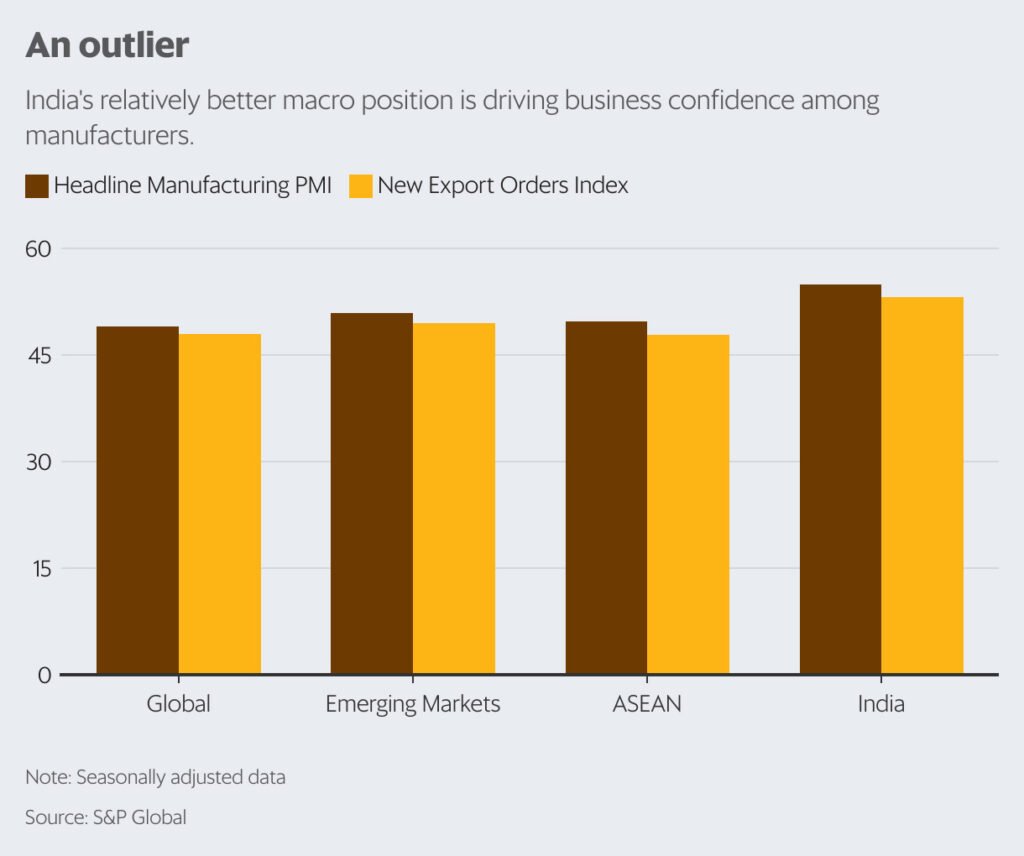India’s manufacturing PMI hit an 18-month low of 54.9 in December. A global and ASEAN slowdown resulted in figures below 50, pointing to a contraction.
Indian Stock Market and Manufacturing Sector Performance
While the Indian stock market achieved new highs in December, the manufacturing sector faced a slowdown. The HSBC Purchasing Managers’ Index (PMI) dropped to 54.9 in December from November’s 56, marking an 18-month low. A reading above 50 indicates expansion, while below 50 signifies contraction.
Manufacturers faced unfavorable conditions causing a slowdown in new orders and muted export sales and output. International orders continued to rise, but new export sales were sluggish.
Global and ASEAN regions experienced worsening manufacturing conditions, with the headline PMI for these regions registering below 50 in December. The US and Japan also reported contractions in manufacturing output. The euro area remained a significant source of weakness in global manufacturing.
Global manufacturing saw declines in new business intakes and international trade flows. India, however, seems relatively better placed due to its higher domestic exposure.

India’s Position Amid Global Manufacturing Slowdown
India’s intrinsic resilience, illustrated by higher domestic exposure and recent GDP growth, has somewhat mitigated the impact of subdued global demand. The Indian economy has benefited from easing oil prices and robust systemic credit growth.
The prevailing slowdown in global manufacturing, nonetheless, presents potential repercussions for India’s business prospects.
India’s Stock Market Amid Global Manufacturing Slowdown
The performance of Indian stock markets against the backdrop of the global manufacturing slowdown is a critical area of examination.
The Indian stock market soared to new peaks in December, but the manufacturing sector experienced a loss of momentum. The HSBC Purchasing Managers’ Index (PMI) dropped to 54.9 in December from 56 in November, marking an 18-month low.
A slow pace of increase in new orders, coupled with muted new export sales and output, contributed to the manufacturing sector’s subdued performance. Despite rising international orders for the 21st consecutive month, the overall scenario portrays a slowdown in manufacturing activity.
In the global and ASEAN regions, manufacturing conditions worsened, indicating a slowdown. The US and Japan also reported contractions in manufacturing output. The euro area remained a significant source of weakness in global manufacturing.
India, benefitting from higher domestic exposure, has, to some extent, mitigated the impact of subdued global demand on its economy. Easing oil prices and robust systemic credit growth have supported India’s GDP growth recently. However, the subdued global demand could have repercussions for India’s business prospects.
The Outlook for India’s Manufacturing Sector
Thamashi De Silva, assistant India economist at Capital Economics, predicts weak external demand in the short term due to slower economic growth in advanced economies. This, combined with a slight softening of domestic demand, may lead to a further slowdown in the manufacturing sector. However, any deceleration in growth is expected to be mild, and India is forecasted to remain an outperformer among emerging markets in 2024.
Impact on Purchasing Costs
Indian manufacturers are experiencing increasing purchasing costs, particularly in chemicals, paper, and textiles. While input cost inflation in December was lower than historical levels, Gaura Sen Gupta, an economist at IDFC First Bank, cautioned that softening prices may offer less support to manufacturers in 2024, potentially impacting industry profits.
Profit Outlook for Manufacturers
Listed company profits were robust in 2023, supported by decreasing input cost pressures, countering the slowdown in nominal sales growth. However, in 2024, reduced support from input cost reduction could affect profits as prices have already softened considerably in 2023.
Challenges with Charge Inflation
For the fourth consecutive month, the rate of charge inflation exceeded that of input prices, as companies raised selling prices in December. If business momentum does not accelerate, it may affect the sector’s pricing power, limiting the potential for significant price increases.
Optimism in Manufacturing Firms
Despite the challenges, Indian manufacturing firms remain optimistic about future production. Anecdotal evidence points to advertising, enhanced customer relations, and new enquiries as significant factors boosting business confidence in December.
In conclusion, The global manufacturing slowdown has had varying impacts across different regions. India’s domestic exposure has played a crucial role in mitigating the effects of subdued global demand. However, the concerns stemming from the manufacturing slowdown in the global economy potentially affect India’s business prospects.
The manufacturing sector in India faces challenges related to weakening external and domestic demand, increasing purchasing costs, and potential profit pressures. However, amidst these concerns, firms are optimistic about future production, signaling a degree of resilience and potential for growth in the coming year.











